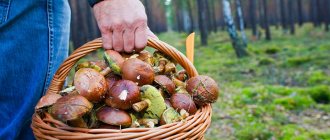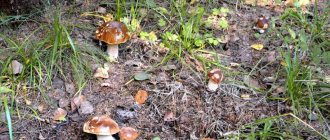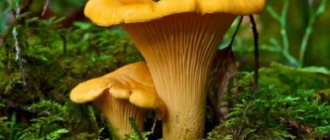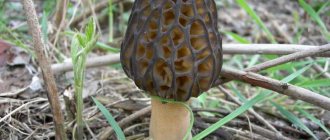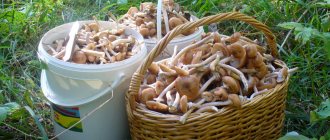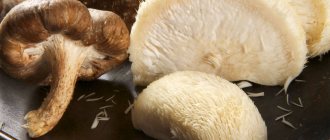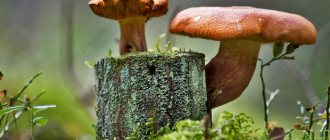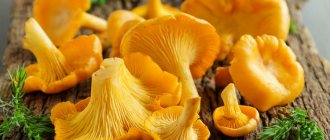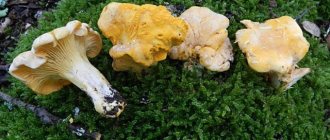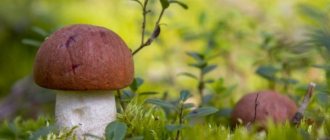The Moscow region occupies a fairly large area - 45,000 km2, a significant part of which is covered with forests. Mushrooms are collected from late spring or early summer. This is the optimal time for a hike, lasting until the first sub-zero temperatures appear. There are many places where to pick mushrooms in the Moscow region: Stupinsky, Kolomensky and the famous Ruzsky districts. Here tourists collect more than one basket of forest gifts.
The best mushroom places of the Moscow region on the map
Quality of early mushrooms
According to statistics, every third Russian becomes a real mushroom picker during the season, while the majority traditionally start picking mushrooms no earlier than mid-June.
The first white boletuses, boletus and boletus are traditionally called “spikes” - their growth coincides with the beginning of heading in the rye fields.
Early mushrooms, however, are not of good quality and are often worm-eaten: fungus gnats and flies happily lay their larvae in them.
Dmitry Tikhomirov, project “Mushroom Hunter” Photo: Natalia SIDOROVA
False honey agaric
The poisonous false honey fungus, unlike its fellows, has rested in the winter and is now trying to confuse beginners when picking mushrooms. After all, not everyone knows that in the spring months only inedible honey mushrooms, which are life-threatening, sprout, while good fruits appear only in the summer.
It’s not difficult to identify a false honey fungus! The gray-yellow color makes the honey mushroom family stand out from the majority. From mid-spring to late autumn they germinate wherever there is fertile soil, logs and rotten stumps.
Best weather for mushroom picking
I will dispel one of the popular myths: mushrooms do not need warm and rainy weather at all, as in the popular expression “mushroom rain” - when it is rain, warmth and sun at the same time.
In fact, mushrooms need the so-called “TVP”, as experienced mushroom pickers in their slang call “temperature-humidity provocation” when the air temperature drops sharply. And if it also rains, then this is what contributes to the beginning of the growth of the fruiting bodies of boletus, boletus, honey mushrooms, and almost all of our best mushrooms. When, on the contrary, it is warm and rainy all the time, the mycelium grows and develops well underground, but this does not make it any easier for us, mushroom pickers. After all, we do not need the thin hyphae (threads) of the mycelium, but the fruit that it bears - a large and beautiful mushroom!
In general, a signal that mushrooms will soon begin to grow is a sharp change in temperature and humidity. This will cause tiny fruiting bodies to form on the mycelium. And if this sharp change lasts at least a few days (two or three, or better yet five), then after a couple of weeks from this moment the mushrooms will develop to normal size, and we will get a more or less intelligible harvest.
How to identify a mushroom from a photo: useful sites and applications
Some people are afraid and do not like to pick mushrooms, for fear of bringing home something poisonous and inedible.
And they do it right! But in the online era, you can easily recognize a mushroom from a photo. The main thing is to know where to look. It turns out there are several smartphone apps that can help you identify your find in seconds. We have collected for you the best websites and applications on the “mushroom” theme. Find out more
Cooking tips
Even edible spring mushrooms need proper preparation before cooking:
- the twisting and folded fruiting bodies of strings and morels must be washed repeatedly and as thoroughly as possible with water, which will completely free them from accumulated forest debris and soil particles;
- Regardless of the type, it is recommended to boil washed and peeled mushrooms twice in salted water;
- It is not advisable to use mushroom broth obtained by boiling the first spring mushrooms for further preparation of first or second courses, as well as appetizers.
It should be remembered that poisoning can be caused by eating fruiting bodies that have a high concentration of heavy metals, pesticides and herbicides, as well as radioactive substances. Among other things, intoxication is often caused by the consumption of mushrooms contaminated with pathogenic microorganisms.
Porcini mushrooms
I went to the pine forest with the secret hope of finding a typical August-September mushroom - the boletus, or pine porcini mushroom, the most valuable trophy for all Russian mushroom pickers.
Despite almost the beginning of summer, in the forest I regularly came across common spring strings, which also mixed up the season, but I don’t take them - I don’t want to bother with boiling them a couple of times, removing the toxin gyromitrin (the common string is a conditionally edible mushroom).
Green moss and bluish reindeer moss are constant companions of boletus. There is no moss - it is useless to look for boletus! The boletus also prefers forests, or more precisely, pine plantings no older than thirty-five years. And the layer of white pine always begins with edges, roadsides and fire ditches. At the beginning of the season, it is useless to look for mushrooms in the forest itself.
Borovik Photo: Ivan SEMENOV
Peering carefully at the slopes of the edge, I miraculously did not crush a brown cap no more than a couple of centimeters in diameter. The May boletus is about three centimeters tall, which did not in any way affect the value of the find. I carefully picked it up with my finger: cutting porcini mushrooms, in my opinion, is the height of blasphemy: after all, up to a third of the thick stem can remain in the soil.
I spend so much time in the forests looking for mushrooms, but I have never found a boletus in the spring. Regular white, birch and spruce (boletus edulis - lat.), as well as oak (boletus reticulatus - lat.) always appear near Moscow at the end of May, which, by the way, not all mushroom pickers know about. But for the dense, thick stem and cherry cap, the most beautiful of the porcini mushrooms - the pine boletus (boletus pinophilus - lat.) ... This happens extremely rarely.
It is boletus mushrooms that like to grow in so-called “bushes”, when several mushrooms appear at once within a radius of up to a meter. And sure enough: as soon as I took a closer look, I noticed four more brownish caps, the most valuable trophy for every mushroom picker. And on the calendar - the last days of May.
Within a couple of hours, the number of boletus found reached thirty.
By the way, under favorable conditions, the boletus can grow up to two centimeters per day.
| Cut or twist: how to pick mushrooms This is probably the most eternal debate among mushroom pickers: cut mushrooms or twist. But mycologists have long ago answered this question unequivocally: twisting and even tearing out mushrooms does not harm the mycelium in any way! Mushroom hyphae (invisible thin threads) cannot be pulled out and damaged; mushrooms are not plants, they simply do not have roots, and even if you dig up a boletus with a shovel, the mycelium will not feel it at all. Picking a mushroom is like picking an apple from an apple tree. In Rus', by the way, mushrooms were never cut until the mid-twentieth century, but, as they said in the old days, they “took”, and there were no fewer mushrooms! |
Mushroom routes for tourists in 2022
Ryazan line
Not far from the railway stations there are forests where you can harvest a good harvest:
- Shchurovo - near the village there are forests with coniferous trees, where noble white and red foxes emerge. GPS06504 and 38.85431
- Lukhovitsy – from the platform to the north there is a forest with birch trees. There are also mushrooms at the edge of the lake. GPS98240, 39.04164
- Chernaya - not far from the station in a pine forest there is a whole forest edge with chanterelles and boletus. GPS02699, 38.91891
- Bronnitsy - towards Plaskinino (5 km) and Biserovo. Geodata 50197, 38.34603
- Faustovo – 4 km from the railway station. GPS44524, 38.49572
Belorusskaya line
- Mushroom plantations near the station: Petelino - 60183, 36.82162, Sushkinskaya platforms - GPS 55.61156, 36.87251, Portnovskaya - 55.58911, 36.74547. To the south of the tracks there is a forest area.
- Not far from the settlements of Alyaukhovo and Raevo (st. Khlyupino and Skorotovo), you should move to the southwest. It is better to go north for porcini mushrooms.
Geodata – 55.67911, 36.91190
Gorkovskaya line
Near the Kazanskoye stations and the Fryazevo platform near the settlement of Vsevolodov. Large harvests of mushrooms are harvested 3 km from the village.
Geolocation –55.78873, 38.57695
Kazan line
- Large harvests of noble mushrooms near Konyashino and Minino (Gzhel station) - 62937, 38.42062
- To the north of the Kuzyaevo settlement, “noble” white and chanterelles grow. There are a lot of them in an abandoned children's camp - 60411, 38.54555
Direction Kyiv
- Mushroom settlements near Bekasovo station – 43256, 36.84076
- Fertile places near Bashkino –31777, 36.67271
Kursk line
- There are a lot of mushrooms at the station called Kolkhoznaya. Not far from the platform – 28091, 37.50456
- There are a lot of honey mushrooms near the Sharapova hunting station - 55.04067, 37.47756
- Different species of forest products are found near the Avangard platform, along the coast of the Rechma River - 96140, 37.45122
Direction Leningradskoe
Near Pokrovka station, tourists collect good mushroom harvests.
Geodata – 56.23753, 36.82999
Direction Paveletskoe
- 4 km west of the Barybino platforms, residents collect full baskets of different species - 33370, 37.85077
- On both sides of the railway tracks of the Mikhnevo and Velyaminovo stations, at a distance of 3 km, there are a lot of forest gifts of any kind - 12111, 37.96093
Direction Riga
- Near the Yadroshino platform, residents find boletus, white, honey mushrooms - 55.94807, 36.61300
- From Rumyantsevo there is a real mushroom forest - 99022, 36.54250
- North of the station called Lesodolgorukovo, mushroom pickers reap large harvests. To find the gifts of the forest you need to head towards Nudol-Sharino and Maryino - 01067, 36.34542
Direction Savelovskoe
- Muscovites get off at Turist and Morozko stations and head towards Grigorkovo, Paramonov, Novlyanka. The forests are rich in different species of mushrooms.
56313.27, 37.49864
- There are many chanterelles 4 km from Taldom station in the southwest of the railway platform. 76544, 37.52764
Direction Yaroslavl
- If you get off at the Sofrino platform after 3 km towards the settlement of Novovoronino, you can find mushroom forests. 13534, 37.92941
- There is a good harvest away from the Semkhoz platform; tourists often go here to pick mushrooms. 28331, 38.07749
Naming the exact place where it is best to pick mushrooms in the Moscow region is sometimes difficult even for an experienced tourist. Locals, every year, going on a “quiet hunt”, remember good places, but are not always able to reap a good harvest there in a few years. This is explained by the life cycle. Hobbyists often pull out the prey along with the mycelium, reducing fruiting.
Mikhail Vishnevsky, biologist and mycologist
“The main mistake mushroom pickers make is searching for the harvest at the beginning of the forest edge. If you want to collect a large basket, you need to get to the place and go 2-3 km deep into the thicket. This will increase the chances, making the trip more effective. This way you can collect the fruits not only for cooking roasts, but also for pickling for the winter.”
Butter
Butterflies Photo: commons.wikimedia.org
You should look for these cute mushrooms (hence the name) exclusively in young pine trees, up to five meters high. I now find early boletus under trees, but most of them are in the tall grass in the field. The main thing here is not to choke the mushrooms and carefully move the thickets apart. But there must be pine trees nearby.
There are two types of butter - granular and real. Many mushroom pickers do not distinguish them, and this is not necessary - among the butter mushrooms there are no inedible species, and it is impossible to confuse them with some false poisonous double.
But if a grainy oiler is common at the beginning of summer, then a real one, denser and more powerful, appears only in August and September. The distinctive features of these two types are that the granular one does not have a film under the cap.
I think there is no finer mushroom for pickling than buttercup. Some mushroom pickers remove the mucous skin from the cap, some boil it with it: it all depends on the individual reaction of the stomach and how aesthetically pleasing you want the mushroom in the jar to be. Without the skin, of course, it’s more beautiful.
| Recipe for pickled butter For one liter of water: 2 tablespoons of sugar, 4 teaspoons of salt, 3 bay leaves, 6 black peppercorns, 3 cloves, 3 cinnamon sticks. Preparation. Add all ingredients to boiling water, remove from heat and add three teaspoons of vinegar essence. Cool. Pour the marinade over the boletus, previously boiled for five minutes with salt and vinegar. Cover (it is better not to roll up to avoid botulism) with a lid and store in a cool, dark place. |
general characteristics
All types of mushrooms are divided into edible, conditionally edible, inedible and poisonous.
Sometimes May mushrooms collected in the Moscow region are used for salads or light snacks without heat treatment. Only edible species, such as champignons and russula, are suitable for this use.
All edible types are fried, boiled and steamed. They are aromatic and can be processed in any way. Used for first and second courses.
Conditionally edible have a specific bitter taste. Therefore, housewives do not particularly like to use them in cooking. To get rid of the unpleasant taste, they are soaked and thoroughly washed in running water. Then it is boiled with the addition of spices and only after that the main cooking begins.
Poisonous mushrooms are truly dangerous to life and health. Their toxins are difficult to remove and the taste is unpleasant. Special craftsmen can prepare fly agarics according to a special recipe (such as Fugo fish). But amateurs should not take risks, because the poison is so toxic that it can cause severe poisoning leading to death.
Flavor categories
May mushrooms of the Moscow region are divided into 4 flavor categories:
- Boletus mushrooms, milk mushrooms, white mushrooms, saffron milk caps and murrelets, etc., which have a strong aroma and bright taste.
- Boletus, boletus, Polish and all types of champignons, etc., are aromatic, with a mushroom taste, but it is somewhat weaker than that of the first group.
- Moss mushrooms, honey mushrooms, russula, etc., all specimens have an average taste, less aromatic.
- All conditionally edible species requiring special pre-treatment.
For gourmet dishes, the first 2 categories are used. Of the 3, they make snacks and pates, and 4 are used more for pickles, to which spices are added to enhance the taste and satisfy the taste buds.
Boletus and boletus
Boletus Photo: Maxim SHANIN, commons.wikimedia.org
The third main mushroom is, of course, boletus. In the south of the Moscow region, towards Kaluga and Ryazan, boletus began to grow along light birch edges literally a few days after the boletus. And every warm day it becomes more and more. And most importantly, these mushrooms are almost worm-free.
Following the boletus, the first aspen boletuses have already begun to appear, which you need to look for along the edges of young aspen and birch trees. In my opinion, only a young boletus in beauty and stature, popularly called “chelysh”, still with an unopened cap, can compete with the boletus.
Bluefoot
One of the most favorite mushrooms among many lovers of quiet hunting is the blue leg. Its main feature is a blue-lilac thickened leg, a light hat and a lattice-like surface under it.
Chanterelle
Chanterelles Photo: commons.wikimedia.org
Chanterelle is the same early mushroom as boletus. In the very south of the region there are already the first finds - this is, of course, chanterelle, which we value not only for its taste, but also for its absence of worms. You need to start looking for these bright yellow mushrooms along the birch edges, but by mid-June the chanterelle, following other mushrooms, will begin to grow in the depths of the forest. And if you come to such a “chanterelle” meadow, then from one mycelium you can easily pick up half a basket. True, there is one subtlety when preparing it: it is better to boil the chanterelle before freezing, otherwise it may taste bitter.
Where to collect
Common morels, as well as such varieties of this mushroom as round, conical and capped morels, are found almost everywhere in the territory of Moscow and neighboring regions. The fruiting bodies of these mushrooms are quite fragile, so they should be collected with extreme caution.
Many of the earliest edible mushrooms appear in large groups on old and rotten stumps or dead wood of deciduous and coniferous wood.
Meadow or field honey mushrooms easily tolerate spring cold at night and prefer rotting deciduous wood, dead wood and rotting chips, stumps and the soil near them. Large groups of edible honey mushrooms can be found in spring in deciduous and mixed forest zones; somewhat less often they grow in coniferous forests, as well as in gardens or parks.
Minskoye Highway: in the process of reconstruction
At Minka, active work is currently underway to put this highway near Moscow in order: in a year or two, traffic here will become traffic-lightless, at least from Lesnoy Gorodok. In the meantime, on weekends, there are significant traffic jams. However, the first “mushroom” place is not so far from Moscow, just north of the Zhavoronki platform. The turn to it will be a kilometer after Likino. True, according to people in the know, in recent years the harvests here have not been so great.
Therefore, it is best to drive a little further – until the turn to Golitsyno. And, having driven about two kilometers, stop on the side of the road near a forest near the Malye Vyazemy platform. It is possible to get lost here, but it is difficult: from the south the forest is limited by the M1 highway, from the north by the Belarusian direction railway.
You can drive even further north – to the vicinity of Zvenigorod or a little further north. They say there are good mushroom places in the vicinity of the Petelinskaya poultry farm, near the village of Chastsy. But you need to go here along the Mozhaisk highway - or through Odintsovo, or, if along Minka, then you need to turn towards Golitsino, and then, at Malye Vyazem - to the left.
Benefit
Forest May mushrooms are beneficial for the human body. They have a lot of fiber, microelements and vitamins. They consist of 90% water, are low in calories (about 22 kcal per 100 g), and are used for dietary nutrition.
The fiber in their composition quite fully replaces a product of animal origin - meat. They stabilize blood pressure, blood sugar levels and stimulate brain activity.
They are successfully used by pharmacists to create medicines for various diseases.
Bohr highway
There is probably no point in trying to leave Moscow along the Borovskoye Highway - on your way you will encounter many traffic lights in Solntsevo (although, once you leave the city, you can drive several kilometers along a very good road). It’s probably better to continue along the same Kievskoye Highway to the repeatedly mentioned turn to Krekshino. And, at the first intersection, turn right onto a narrow two-lane road. Along it you will reach the village of Pobeda, the border of the town of Aprelevka. Leave your car here, cross the tracks of the Kyiv direction of the railway, and all the local mushrooms are yours.
How to get there
In the Podolsk region, mushroom places can be found by taking a train trip. You need to go towards Serpukhov. Mushroom pickers or neighbors in the carriage can help you choose a station.
To some mushroom places you need to go by train
Favorite stations:
- Ray;
- Chekhov;
- Vanguard;
- Kolkhoz;
- Sharapova's hunt.
After getting off the train, you will have to walk several kilometers. If you are visiting for the first time, try to join a group of mushroom pickers, or at least don’t hesitate to ask the locals for directions.
